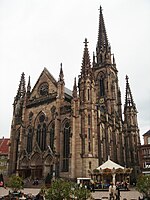Mulhouse-Ville station
20th-century architecture in FranceBuildings and structures completed in 1932Buildings and structures in MulhouseGrand Est railway station stubsHaut-Rhin building and structure stubs ... and 2 more
Railway stations in France opened in 1839Railway stations in Haut-Rhin

The Gare de Mulhouse-Ville, also known as Gare Centrale, is the main railway station in the city of Mulhouse, Haut-Rhin, France. It is the eastern terminus of the Paris-Est–Mulhouse-Ville railway.
Excerpt from the Wikipedia article Mulhouse-Ville station (License: CC BY-SA 3.0, Authors, Images).Mulhouse-Ville station
Gare Centrale, Mulhouse Rebberg
Geographical coordinates (GPS) Address Nearby Places Show on map
Geographical coordinates (GPS)
| Latitude | Longitude |
|---|---|
| N 47.7426 ° | E 7.3433 ° |
Address
Gare Centrale
68100 Mulhouse, Rebberg
Grand Est, France
Open on Google Maps








